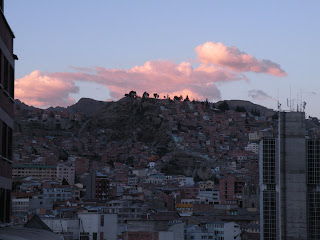From Santa Cruz we made our way to Trinidad which was basically just a stopping-over point for us on the way to Rurrenbaque. From Trinidad we boarded a bus to Rurrenbaque in the Amazon Basin. Perhaps now is a good time to describe traveling by bus in Bolivia...
Most busses are over-used, run-down, and suffer break-downs regularily.
Most roads in Bolivia are not paved - even ones connecting major cities.
The altitudes in Bolivia vary dramatically between the highlands of the altiplano and the lowlands of the Amazon Basin which means that most roads are narrow switchbacks making their way up and down mountains. Typical busses(below) in Bolivia have high-clearance, knobby tires, and snorkles for their exhaust pipes so that they can cross smaller rivers.

We arrived in Bolivia at the end of the rainy season. Many roads in the Amazon Basin were still washed out which meant longer travel times. In many cases, where the roads were washed out, the busses would drive onto make-shift rafts propelled by dug-out canoes. Passengers on the bus were usually asked to exit the bus and stand on the raft - if the bus and raft went down you would have more of a chance to swim to safety.
 Pampas(Amazon) Tour:
Pampas(Amazon) Tour:We arrived in the Amazon basin the small town of Rurrenbaque which is located on the Beni River. There are more than 60 tourism agencies in town so it took us a while to decide upon an agency and tour. We finally decided upon a 3 day tour of the pampas. We would visit the newly protected Pampas Del Yucama, a 616,000 ha protected area. The Pampas Del Yucama is part of an extensive fluvial plan of the Amazon Basin characterized by flooded savannas and jungle vegetation and wildlife.

We headed up the Beni river in a small 9 passenger boat with our tour guide Negro and 6 other trekkers. Negro was quite a character and had lost his index finger too an Alligator. Our accomodations for the tour were small cabins on the rivers edge, elevated on stilts, complete with bunks and mosquito nets. Almost right away we were amazed at the biodiversity and variety of species found along the river. Some of the wildlife we were able to view included 3 toed sloths, cappybearas, anacondas, and a variety of other species shown below.
Parrots flying over-head(above). It was a birders paradise along the river and we were lucky enough to see a large variety of birds including herons and many different species of eagles.

Squirrel monkey checking us out(above). We were lucky enough to see 5 different species of monkeys including howler monkeys. In the morning we could hear the low growl of the howler monkey. The growl sounds similar to a lion and is meant to make other howler monkeys aware of its territory.
A squirrel monkey feasting on a banana the guide negro placed on Chris´ head(below).

Our days consisted of motoring up and down the rivers viewing wildlife. There were many alligators along the way, often basking on the muddy shores of the river. This alligotor(below) had just entered the river after we boated up to it for a closer look.

An alligator hanging out in the sun by one of the river eco-lodges(below).
We were suprised and amazed to learn that the Beni river and many other headwaters of the Amazon are home to pink river dolphins. Getting a good picture of a dolphin is just as hard as getting a picture of a whale - ofter you just get the a ripple of water or the spout as they surface for air.

Rebecca enjoying a refreshing dip in the river and treading water in the river(below), waiting for a river dolphin(hopefully not an alligator) to tap her on the bottom of her feet.



 The women of the island we visited signing us a departure song in the local language, Q´uechua
The women of the island we visited signing us a departure song in the local language, Q´uechua








 Bolivia Fun Fact:
Bolivia Fun Fact:
 From our hostel we were able to walk down to the famous Mercado de Hechiceria(Witches Market). The market is overflowing with herbs, magical potions and shriveled llama fetuses, which locals bury under the porches of their new homes for luck and fortune.
From our hostel we were able to walk down to the famous Mercado de Hechiceria(Witches Market). The market is overflowing with herbs, magical potions and shriveled llama fetuses, which locals bury under the porches of their new homes for luck and fortune. 




 Squirrel monkey checking us out(above). We were lucky enough to see 5 different species of monkeys including howler monkeys. In the morning we could hear the low growl of the howler monkey. The growl sounds similar to a lion and is meant to make other howler monkeys aware of its territory.
Squirrel monkey checking us out(above). We were lucky enough to see 5 different species of monkeys including howler monkeys. In the morning we could hear the low growl of the howler monkey. The growl sounds similar to a lion and is meant to make other howler monkeys aware of its territory. 
 An alligator hanging out in the sun by one of the river eco-lodges(below).
An alligator hanging out in the sun by one of the river eco-lodges(below).
 Rebecca enjoying a refreshing dip in the river and treading water in the river(below), waiting for a river dolphin(hopefully not an alligator) to tap her on the bottom of her feet.
Rebecca enjoying a refreshing dip in the river and treading water in the river(below), waiting for a river dolphin(hopefully not an alligator) to tap her on the bottom of her feet. 

















